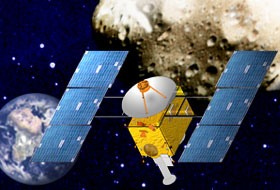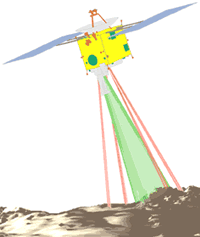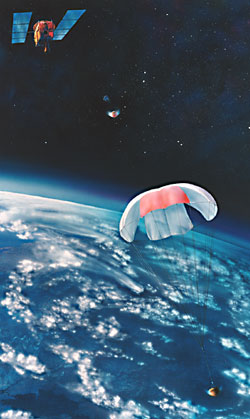The Japanese Space Agency's Yabusa spacecraft (also known as MUSES-C) will study the asteroid Itokawa from the series known as near-Earth asteroids

The Japanese Space Agency's Yabusa spacecraft (also known as MUSES-C) will investigate the asteroid Itokawa from the series known as near-Earth asteroids. Through the mission, the Institute for Space and Astronautical Sciences (ISAS) will test the technologies that will allow bringing back to Earth a sample from the surface of an asteroid. However small these samples may be, they will allow a detailed analysis of these particles in the laboratory. The scientific value of the samples is enormous.
There are several sample return missions in various stages of preparation around the world. While these missions require a large-scale rocket, Japan has explored the possibility of launching a mission that would require a small spacecraft with the goal of discovering another accessible asteroid and developing an efficient electric propulsion system for the spacecraft.
The main task of the MUSES-C mission is to make sure that the technology is capable of carrying out the goal - flying to an asteroid and returning a sample from it. "We are convinced that this mission will provide us with the technical and technological data that will allow us to promote the ability to return samples in the future.
For more than two and three months after its launch in May 2003, the Yabusa spacecraft traveled a long way from Earth using its gravity on a May 2004 flyby.
It will be the first low-thrust spacecraft to rendezvous with asteroid Itokawa (1998SF36) next month.
Meanwhile, the Yabusa spacecraft imaged its target comet at the end of July, on August 8-9 and on August 12. A total of 24 photos. The integrated navigation system that includes both radio and optical measurement systems uses these images to guide the spacecraft toward final approach to the object.
The navigation system, which operates at a slow rate due to the use of an ion engine, successfully performed its first ignition. During the coming weeks, the comet will also be photographed using a high-resolution camera.
The spacecraft carries three reaction wheels. In one of them, the one responsible for rotation on the X axis, a malfunction occurred on July 31. However, the spacecraft is also equipped with software to repair a double-reaction wheel and it has been activated. The spacecraft resumed its stable flight and is functioning normally.
The spacecraft team is convinced that it will achieve the avenue of scientific observations, including taking the expected sample during the connection phase.
The spacecraft was found on August 12, the day the news was last updated on the Japanese Space Agency's website, at a distance of 35 km from its destination (currently the distance is less than 9,000 km) and at a speed of 38 meters per second. This is incredible speed that will allow for a low thrust encounter never before attempted. The spacecraft will turn off its ion engine at a distance of 3,500 km from the object and continue at the residual speed to reach a speed of 10 meters per second. The deceleration will be done through a reaction control system. In mid-September, the spacecraft will reach a relative distance of 20 kilometers from the asteroid.
After that, the spacecraft will continue to accompany the comet for the time it takes to study the area and find the landing site. Then the spacecraft will begin to approach the asteroid.
First, it will perform measurements of the relative distance and height from the surface using two devices designed for this purpose. During the approach, the spacecraft will adjust its engines independently and it will transmit images to Earth during this entire process. Although the control center on Earth will not be able to maneuver the spacecraft because it will be 10 light minutes away, it will be able to send a command if the controllers detect danger but no more. Most of the important decisions must be made by the spacecraft itself.
At an altitude of 100 meters, the spacecraft will drop a target marker onto the asteroid's ground. The marker, with a diameter of about 10 centimeters, will shine on the surface of the asteroid and will return the flash beam from the spacecraft according to which it will also land. From this point on, a device known as LRF will be activated that measures the distance between the spacecraft and the surface, as well as the
The slope of the surface using radial projection of multiple rays. Another device, FBS will be used to detect a crash hazard on the surface.
After approaching the surface of the asteroid and before the final touch down with the ground, the spacecraft will stop its engines and fall into free fall. This is to prevent the jets from contaminating the surface of the asteroid by getting too close to it. From this point, the engines will remain in the closed position until the sampling task is completed. After the descent in free fall, the sampling will begin immediately. An excavator will then remove the sample and put it into the spacecraft. Immediately after sampling, the spacecraft will activate its engines and immediately take off, resume hovering at a height of 100 meters and wait for the next command from Earth.
Sampling techniques

How will the samples be collected? Compared to the Moon's gravity, less than one-sixth that of Earth, the gravity on the asteroid's surface is minuscule, less than one hundred thousandths of Earth's. If an excavator or any other tool for digging that is secured by a strong anchor to the surface is not used, the spacecraft may be pushed away before the excavator digs a hole. Apart from this, there is another factor that makes it difficult to take the sample, and that is that we do not know what the asteroid is really made of. After all, that's why the spaceship gets there in the first place.
It turns out that the Japanese have not yet decided on which method the excavation will be carried out, apparently the instruments in the spacecraft are capable of a variety of options depending on the conditions on the ground.
Return to Earth

In the final phase of the mission, a small capsule that will contain the asteroid sample will enter the Earth's atmosphere in mid-2007 at a speed of 12 kilometers per second. The maximum heating rate of the capsule back into the atmosphere is tens of times higher than that of the space shuttle and several times that of the Apollo return chambers. The material from which the heat shield is made was developed with the newest technologies. After the spacecraft is slowed by the atmosphere, it will release parachutes for a soft landing. The capsule will be located according to the radio location that will be transmitted, and thus it will be possible to extract it.
